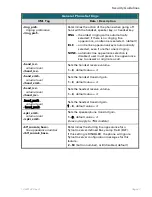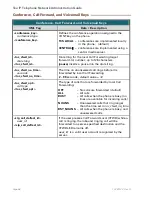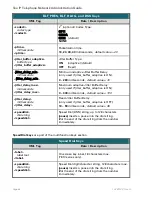
Teo IP Telephone Network Administration Guide
Page 50
13-280132 Rev. Q
{|
1425
}
Since there are no digits in front of the bar in the prefix operation, the digits
after the bar are added to the dialed digits, which match the dial string, when the phone
sends them out.
[
3-5,9
]
^^^^^^
#
A couple of new things are in the dialed string. The square brackets
[]
indicate that the string matches the dialed digits if any of the digits within the brackets are
dialed in that position in the string. The dash indicates a range of characters, so 3-5
indicates that the digits 3, 4 or 5 are a match. If any of the digits 3, 4, 5 or 9 are dialed as the
first digit, the string is matched. The
^
is a “wild card” which matches any dialed digit in
that position in the dial string. In this case, the next 6 digits after the first can be any valid
digit. Again the
#
terminator indicates that once you have a matching string, perform the
prefix and suffix operations and then send the resulting digits.
{|}
Like the previous example, no suffix operation is to be performed on dialed digits
that match the dial string.
Combining the two previous examples results in the following dial plan.
<dial_plan>{
911
|
2584357
}
911#
{|}|{|
1425
}[
3-5,9
]^^^^^^
#
{|}</dial_plan>
The two components
{
911
|
2584357
}
911#
{|}
and
#
{|
1425
}[
3-5,9
]^^^^^^
#
{|}
are
separated by a “
|
“. If 911 is dialed by the phone user, 2584357 will be immediately dialed
by the phone. The first component matches before enough digits are dialed for the second
component have a matching string. If 9234567 is dialed, the first component will stop
processing after the second digit and the second component will continue process the
digits since they meet the requirements of the dial string. The digit string 14259234567 will
be sent out. If 811 is dialed, the dial string in neither component is matched and the phone
sends out 811 after the dial timeout or after the user enters # from the keypad.
<dial_plan>{|}^^`{|}|{|}
771900
^^^^^^^!{|}|{
77
|}
771
^^^^^^^^^^
#
{|}</dial_plan>
The above dial plan has 3 components. It introduces two more special characters:
`
and
!
.
The
`
can have two meanings based on where it is located. The first is as a secondary dial
tone indicator when in the dial string. The second is as a meta operation marker, which we
will discuss later. The
!
is a block access marker. If the dialed string matches the dial string
for this component, the user gets reorder and the phone does not generate a call.
{|}^^`{|}
The first component will cause the phone to generate dial tone after the user
dials any two digits.
{|}
771900
^^^^^^^
!
{|}
The second component configures the phone so that for any call
that begins with 771900 and has a total of 13 digits (digits shown plus 7 wild card digits),
will be restricted.
{
77
|}
771
^^^^^^^^^^
#
{|}
The last component will for a dialed digit string that is 13
characters long and begins with a 77, strip off the 77 and immediately send the remaining
string. So if a user dials 7718005551212, the phone will immediately send 18005551212.
M
M
L
L
P
P
P
P
M
M
e
e
t
t
a
a
O
O
p
p
e
e
r
r
a
a
t
t
i
i
o
o
n
n
E
E
x
x
a
a
m
m
p
p
l
l
e
e
For a detailed explanation of meta operations, refer to the Appendix B on page 75.
Summary of Contents for 4101
Page 6: ...Teo IP Telephone Network Administration Guide Page 6 13 280132 Rev Q ...
Page 16: ...Teo IP Telephone Network Administration Guide Page 16 13 280132 Rev Q ...
Page 18: ...Teo IP Telephone Network Administration Guide Page 18 13 280132 Rev Q ...
Page 23: ...XML Configuration Files 13 280132 Rev Q Page 23 ...
Page 24: ...Teo IP Telephone Network Administration Guide Page 24 13 280132 Rev Q ...
Page 70: ...Teo IP Telephone Network Administration Guide Page 70 13 280132 Rev Q ...
Page 72: ...Teo IP Telephone Network Administration Guide Page 72 13 280132 Rev Q ...
Page 86: ...Teo IP Telephone Network Administration Guide Page 86 13 280132 Rev Q ...
















































